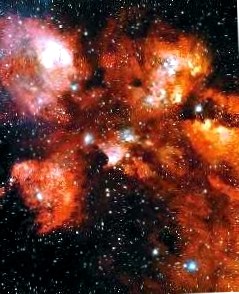The story of the stars
Astronomers are delving deeper and deeper into the depths of space, and the data they collect is revealing more and more about the formation, growth and decay of stars. Now it appears that the peak of stellar births was reached five billion years ago. And it becomes darker and darker in the cosmos.

Cat’s Paw Nebula, NGC 6334, a complex region of newly forming stars in the constellation Scorpio, Image: Canada-France-Hawaii Telescope
In the current ie of the science journal Nature, Alan Heavens, Benjamin Panter and James Dunlop of the University of Edinburgh and Raul Jimenez of the University of Pennsylvania report on the history of the universe. They took a closer look at the stellar population of nearby galaxies and discovered something astonishing: the climax of star formation took place five billion years ago, and since then Mother Cosmos has not been so generous with children.
Prior to this study, astronomers had amed, based on observations of young stars in distant galaxies, that the stellar birth rate had been declining for the past eight billion years. According to the new findings, however, the cosmic era of reduced fertility began much later. When our sun began to shine 4.7 billion years ago, half of the stellar mass had already been created since the Big Bang. Since then, the rate of new star formation has been falling steadily, by a factor of about ten to the present day. The understanding of the history of star formation in the universe is essential for modern cosmology, because it is crucial to understand how galactic structures were formed.
The British-American team led by Heavens analyzed data from the Sloan Digital Sky Survey" (SDSS) of nearly 100,000 galaxies in our vicinity. The Sloan Digital Sky Survey project, a consortium of international institutes and universities, maps the sky and examines the distribution of galaxies in space (cf. A virtual telescope for the simulated universe). Only recently, with the help of these astronomical maps, new evidence for the dominance of dark energy in space was presented (cf. Dark energy matters!).
Now a new sensation emerges from the SDSS data. The researchers analyzed the "Fossils" of galaxies and, in addition to shifting the most mating cosmic time, concluded that galaxies have different histories depending on their masses. The coarser the stellar mass of a galaxy, the earlier its stars formed. Our galaxy, the Milky Way, is one of the most massive, whose suns formed early.
Raul Jimenez comments:
If we want to understand how structures in the universe form and evolve, then we need to understand the history of stars. Fortunately we can read the history of the stars. If we analyze all light – that is, the entire spectrum of visible light – coming from a particular galaxy, then we can effectively see the entire documented fossil record of that galaxy at a glance.
Unlike anthropologists, they had to look up in the sky to discover these fossils instead of digging in the ground. Writing history by observing colors.
To cope with the amount of data generated, Heavens and Jimenez developed the "Multiple Optimized Parameter Estimation and Data Compression" (MOPED), a compression system for analyzing starlight (cf. Recovering Physical Parameters from Galaxy Spectra Using MOPED. Jimenez explains the approach:
Stars with different masses evolve with different luminosities, so by looking at the whole spectrum of a galaxy, we can track these different luminosities to determine the mass and how long ago they were born. Our method includes all stars present in the observed galaxies today, allowing us to write the most complete history of star formation ever compiled.
Since the birth climax five billion years ago, new stars are formed more and more rarely, because they cannot form as fast as old stars die. So it’s getting dammerig in the universe.